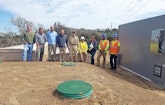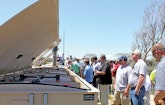
One of the AdvanTex AX-Max pods is set at Coral Bay Club in Atlantic Beach, North Carolina. Because of space limitations, the treatment system is located across the street from the club with pipes carrying wastewater under the street. A second pod was set where the excavator sits. The 1,000-gallon tank in foreground settles any debris that might get into the pipes running between the pods and the septic tanks next to the club building. Pictured are Jon Meade, Green Engineering, left; Zach Conrad, Quality Septic, right rear; Matt Aaron, Quality Septic, right front; and Edward Faison, the owner of Quality Septic, in the Cat excavator. (Photos courtesy of AQWA Inc.)
There was nothing really wrong with the onsite system serving the Coral Bay Club in Atlantic Beach, North Carolina. It had grown as the club had grown, but wastewater disposal wasn’t working as well as it should, says Steve Barry, president of AQWA Inc., in Wilson, North Carolina. His company was a product vendor for the project and operates the system.
At times the wastewater flow in the old system exceeded permit limits, and there was a high nutrient load on the soil. Like other places, North Carolina has had a nitrogen standard in place for some time, Barry explains, and most systems with similar loading have nitrogen-reduction equipment.
Atlantic Beach is on a barrier island, so there is little municipal sewer coupled with a high development density and a sensitive environment. Coral Bay needed a system capable of quickly transforming high wastewater flows into water safe for the ocean in the club’s backyard.
System details
The Coral Bay system is divided into three sections on two sides of the road in front of the club. This is done because of space constraints. There wasn’t enough space on either side of the road to hold all of the components. Next to the club building are a set of tanks that collect water and provide primary septic treatment. On the opposite side of the road are components for secondary aerobic treatment. Then water is moved back across the road for dispersal in a dripfield.
Wastewater leaves the main building through a 6-inch pipe with two branches, one for the kitchen and the other for the rest of the facility.
Kitchen wastewater flows into a 4,000-gallon two-chamber concrete grease trap, then joins the main collection pipe. The combined flow enters a 10,000-gallon two-chamber tank that is followed by an 8,000-gallon two-chamber tank. These handle settling and pretreatment.
“It’s a little bit oversized, but that’s because of the strength of the waste,” Barry says.
Next in series is a 10,000-gallon pump tank with dual Orenco PF200512 20 gpm, 1/2 hp pumps. Water is pushed out through a 2-inch line and travels about 300 feet across Highway 58 to the secondary treatment components. Lines to move water back and forth across the road were directionally bored.
Pretreatment tanks came from Shoaf Precast of Lexington, North Carolina. All were buried under a parking lot and are rated for traffic. Traditional traffic-strength risers give access to tanks. Other risers and lids came from Orenco.
First is a 1,000-gallon trash tank. If there is a break in the wastewater line, any grit or debris will settle here before reaching the AdvanTex pods, Barry says.
Two 42-foot long Orenco AdvanTex AX-Max pods were set about 5 1/2 feet in the ground, leaving about 2 1/2 feet above grade so operators can easily reach inside the tank. “The whole idea there is to make it as operator-friendly as possible,” Barry says.
The first pod is filled with a lightweight, highly absorbent engineered textile media. The second pod has two chambers. First is an upflow filter made with used, chipped auto tires, rubber with metal removed, as a growth medium. Between 25% and 50% of water is returned from here to the head of the plant. MicroC is added for nitrogen reduction. The second chamber is all textile with recirculation for a final polish. Effluent flows by gravity through Orenco UV units before entering a 4,500-gallon pump tank with duplex 1.5 horsepower Orenco pumps. This sends water back across the road for dispersal.
Beside the AdvanTex pods is a propane-powered emergency generator. It’s a regulatory requirement in North Carolina because of the frequency of hurricanes, Barry explains.
Oversizing the dripfield
The supply line runs into a head works with an Orenco UV unit and Netafim filter, and then is dispersed in 14,000 square feet of Geoflow divided into five zones and buried under the large lawn in front of the main club building. Two zones operate at any one time, and one zone is flushed. Ball valves allow the zones to be isolated in case of a problem, and there are air release valves inside a hatch so operators can check line pressures.
Although state rules would have allowed less drip tubing, Barry says his experience with sandy soils shows that sometimes dripfields can be undersized, which won’t allow the treated water to be moved to the soil fast enough. Installing extra drip tubing isn’t that expensive, he says.
At the west end of the club building is a snack bar for the pool. A grease trap and septic tank handle preliminary treatment of wastewater from the snack bar, and wastewater then flows to the main treatment system through about 350 feet of 6-inch pipe. Original piping for this small system was 4-inch, but it was expanded to 6-inch so the run would be flatter, Barry says.
“It had to be done well and a little delicately because it was next to an existing structure in sand,” he adds.
An Orenco panel controls the system and includes a panel with a cellular phone link that Barry can use to log in and check the system.
Installation was done by Quality Septic, Swansboro, North Carolina. Barry says he has worked with owner Edward Faison for almost 20 years, and adds that the installer does outstanding work.
Challenges
Construction was planned for the off season. On the North Carolina shore, Barry says, January and February can be miserable with temperatures of 40 degrees and winds of 20 mph. Tourist season ends about mid-October.
The 2019 preconstruction meeting was on Jan. 7, and work began on Jan. 15. Inspection of the finished system came on March 11.
During the project, technicians had to remove most of the old drainfield, Barry says. “We tried to argue with the state to put drip tubing over the old drainfield.” But the state allowed overlay only in places where the old drainfield was set deep, he says.
“This layout of using the AX-Max and then upflow and tertiary Max unit is something we’ve reproduced at a few sites,” Barry says. The reason, he says, is consistently good performance: nitrogen less than 10 mg/L, ammonia less than 1 mg/L, and BOD and TSS typically below reportable values.
During the summer, BOD runs 400 to 500 mg/L because the club hosts weddings and has a full kitchen. “So the strength of the waste is quite high.” Numbers are good enough for water reuse although the system isn’t permitted that way, he says.
The system has been humming along for three years, Barry says. Typically these systems require site visits twice a week throughout the year, but because of telemetry, the state allows his technicians to visit only weekly during the season and monthly during the off season.
During the winter, daily flows of 500 to 1,000 gpd are enough to keep microbes alive with the help of the carbon feed and recirculation.
Putting the AdvanTex pods partly above ground and purchasing long-warranty pumps show that this system is intended to keep going, Barry says. “It’s really built with operation and long-term operation in mind.”











